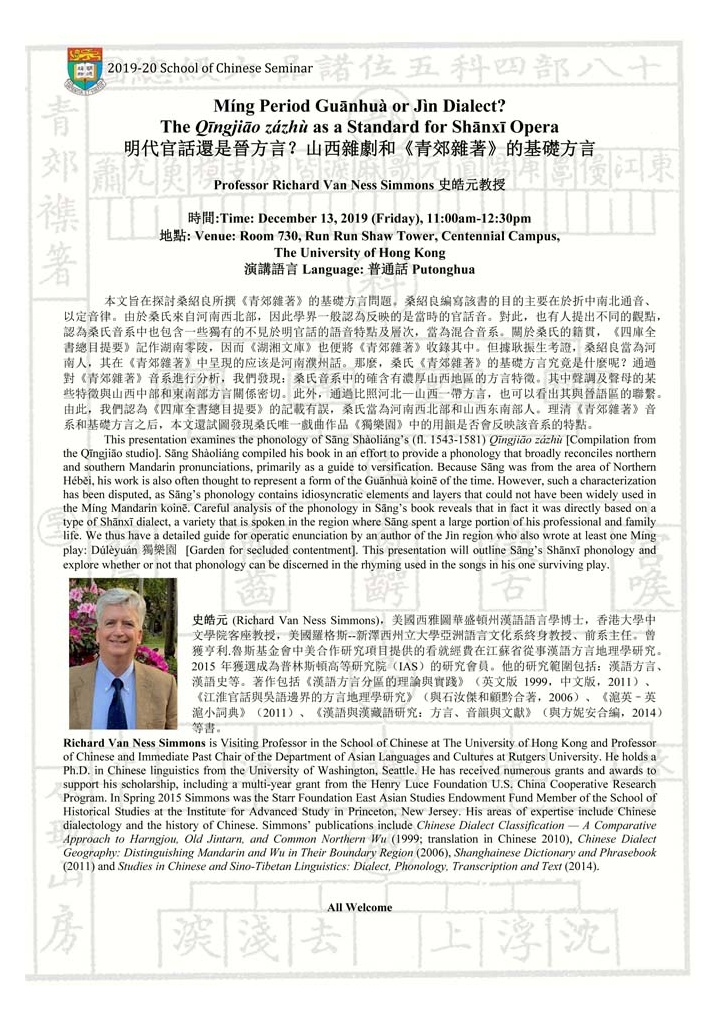[Postponement of the seminar] 明代官話還是晉方言?山西雜劇和《青郊雜著》的基礎方言

Please note that the below seminar is postponed. The new date will be advised in due course.
2019-20 School of Chinese Seminar
Míng Period Guānhuà or Jìn Dialect?
The Qīngjiāo zázhù as a Standard for Shānxī Opera
明代官話還是晉方言?山西雜劇和《青郊雜著》的基礎方言
Professor Richard Van Ness Simmons 史皓元教授
時間:Time: December 13, 2019 (Friday), 11:00am-12:30pm
地點: Venue: Room 730, Run Run Shaw Tower, Centennial Campus,
The University of Hong Kong
演講語言 Language: 普通話 Putonghua
本文旨在探討桑紹良所撰《青郊雜著》的基礎方言問題。桑紹良編寫該書的目的主要在於折中南北通音、以定音律。由於桑氏來自河南西北部,因此學界一般認為反映的是當時的官話音。對此,也有人提出不同的觀點,認為桑氏音系中也包含一些獨有的不見於明官話的語音特點及層次,當為混合音系。關於桑氏的籍貫,《四庫全書總目提要》記作湖南零陵,因而《湖湘文庫》也便將《青郊雜著》收錄其中。但據耿振生考證,桑紹良當為河南人,其在《青郊雜著》中呈現的应该是河南濮州話。那麼,桑氏《青郊雜著》的基礎方言究竟是什麼呢?通過對《青郊雜著》音系進行分析,我們發現:桑氏音系中的確含有濃厚山西地區的方言特徵。其中聲調及聲母的某些特徵與山西中部和東南部方言關係密切。此外,通過比照河北—山西一帶方言,也可以看出其與晉語區的聯繫。由此,我們認為《四庫全書總目提要》的記載有誤,桑氏當為河南西北部和山西东南部人。理清《青郊雜著》音系和基礎方言之后,本文還試圖發現桑氏唯一戲曲作品《獨樂園》中的用韻是否會反映該音系的特點。
This presentation examines the phonology of Sāng Shàoliáng’s (fl. 1543-1581) Qīngjiāo zázhù [Compilation from the Qīngjiāo studio]. Sāng Shàoliáng compiled his book in an effort to provide a phonology that broadly reconciles northern and southern Mandarin pronunciations, primarily as a guide to versification. Because Sāng was from the area of Northern Héběi, his work is also often thought to represent a form of the Guānhuà koinē of the time. However, such a characterization has been disputed, as Sāng’s phonology contains idiosyncratic elements and layers that could not have been widely used in the Míng Mandarin koinē. Careful analysis of the phonology in Sāng’s book reveals that in fact it was directly based on a type of Shānxī dialect, a variety that is spoken in the region where Sāng spent a large portion of his professional and family life. We thus have a detailed guide for operatic enunciation by an author of the Jìn region who also wrote at least one Míng play: Dúlèyuán 獨樂園 [Garden for secluded contentment]. This presentation will outline Sāng’s Shānxī phonology and explore whether or not that phonology can be discerned in the rhyming used in the songs in his one surviving play.
史皓元 (Richard Van Ness Simmons),美國西雅圖華盛頓州漢語語言學博士,香港大學中文學院客座教授,美國羅格斯–新澤西州立大學亞洲語言文化系終身教授、前系主任。曾獲亨利.魯斯基金會中美合作研究項目提供的看就經費在江蘇省從事漢語方言地理學研究。2015年獲選成為普林斯頓高等研究院(IAS)的研究會員。他的研究範圍包括:漢語方言、漢語史等。著作包括《漢語方言分區的理論與實踐》(英文版1999,中文版,2011)、《江淮官話與吳語邊界的方言地理學研究》(與石汝傑和顧黔合著,2006)、《滬英–英滬小詞典》(2011)、《漢語與漢藏語研究:方言、音韻與文獻》(與方妮安合編,2014)等書。
Richard Van Ness Simmons is Visiting Professor in the School of Chinese at The University of Hong Kong and Professor of Chinese and Immediate Past Chair of the Department of Asian Languages and Cultures at Rutgers University. He holds a Ph.D. in Chinese linguistics from the University of Washington, Seattle. He has received numerous grants and awards to support his scholarship, including a multi-year grant from the Henry Luce Foundation U.S. China Cooperative Research Program. In Spring 2015 Simmons was the Starr Foundation East Asian Studies Endowment Fund Member of the School of Historical Studies at the Institute for Advanced Study in Princeton, New Jersey. His areas of expertise include Chinese dialectology and the history of Chinese. Simmons’ publications include Chinese Dialect Classification — A Comparative Approach to Harngjou, Old Jintarn, and Common Northern Wu (1999; translation in Chinese 2010), Chinese Dialect Geography: Distinguishing Mandarin and Wu in Their Boundary Region (2006), Shanghainese Dictionary and Phrasebook (2011) and Studies in Chinese and Sino-Tibetan Linguistics: Dialect, Phonology, Transcription and Text (2014).
All Welcome









